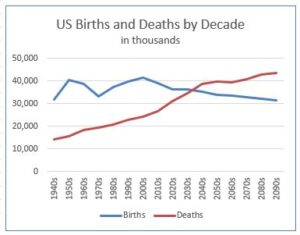Demography As Destiny – Part Two
Following the rise in births in mid-20th-century, and again at the century’s end, annual births in the U.S. have been steadily declining. Add to that an aging population with deaths on a constant upward trend, and soon the inevitable will occur: the U.S. will record more deaths annually than births.
 The latest population projections from the U.S. Census Bureau place that year as 2038. That is according to the “main series” of alternative scenarios for the course of population growth to the end of the 21st century. Scenarios assuming lower and higher net migration shifted the transition year to 2036 and 2042 respectively.
The latest population projections from the U.S. Census Bureau place that year as 2038. That is according to the “main series” of alternative scenarios for the course of population growth to the end of the 21st century. Scenarios assuming lower and higher net migration shifted the transition year to 2036 and 2042 respectively.
Once the population stops growing due to natural increase, defined as births minus deaths, net migration, the other component of population change, will set the course of population projections. New projections offer four scenarios for net migration.
The current U.S. population is estimated to be 340 million. The main series of projections foresees the U.S. population reaching a peak of 369 million in 2080 before starting to decline. The low migration projection would reach a peak of 346 million in 2043, while the high projection would result in population growth beyond year 2100 total of 435 million. A zero migration projection would result in the population declining after 2024 to a total of 226 million by 2100.
 The message these projections present is clear: unless net migration reaches and maintains a level of 1.5 million per year, the U.S. population will age and decrease. An aging population has a higher proportion of elderly to working age people. This ratio, called the dependency ratio, was discussed at length in a May 2015 Fifty Year Perspective blog post. Many countries that in the past have had four or more workers to support each elderly person are moving toward a ratio of 1.5 per elderly person, or less.
The message these projections present is clear: unless net migration reaches and maintains a level of 1.5 million per year, the U.S. population will age and decrease. An aging population has a higher proportion of elderly to working age people. This ratio, called the dependency ratio, was discussed at length in a May 2015 Fifty Year Perspective blog post. Many countries that in the past have had four or more workers to support each elderly person are moving toward a ratio of 1.5 per elderly person, or less.
An exception is the continent of Africa. A later blog post in April 2019, and another in October 2023, documented the high percentage of young people in African countries, and the future of the world’s labor force residing in rising proportions in African countries.
There is wide variation among the four projections newly released by the U.S. Census Bureau. However, all of them promise significant change in the world’s national populations, government stability, and economic viability. One of the first two posts of Fifty Year Perspective, in June 2014, was titled “Demography as Destiny.” Graphic displays presented the dramatic changes occurring in age structure over time and between continents. The new population projections for the U.S. reveal equally dramatic changes in the size of the population.
